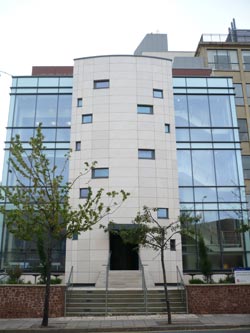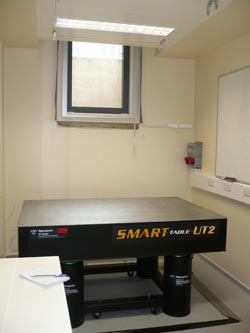
low vibrations
By Michael Banks
Yesterday I visited what is supposed to be the “quietest building in the world”. Being in Bristol and only a few kilometres away from our office, there was really no excuse but to visit.
The £11.5m Bristol Centre for Nanoscience and Quantum Information (NSQI) is housed at the University of Bristol next to the physics department.
Construction of the quietest building has taken over two years to complete and is seemingly quiet due to the huge amounts of concrete that have been poured into the ground beneath it.
“There is more than 2 m of concrete beneath our feet,” says Fred Hale, building manager of the NSQI, as he shows me round the basement of the building. “This is the right building, in the right place.”
The site in Bristol is well suited to hosting such a quiet lab since the ground under the building consists of solid rock.
Engineers excavated a one-storey deep hole in the rock and then filled it in with concrete. The centre was then constructed on this rather solid base.

The quietest room in the world
The four-storey building has a number of “quiet rooms” in the basement, where most of the experiments are housed. Each experiment then sits on an additional 24 tonne block of concrete separated from the floor by rubber bearings.
And if that wasn’t enough, each lab in the basement also sits inside a Faraday cage, and the temperature, air flow and acoustic noise in the room can also be strictly controlled.
So how does a building, or room, get to be called the quietest in the world? Well, according to Hale, the engineering firm that helped to build the rooms – Arup – reckon that vibration measurements taken on the concrete blocks are the lowest they have ever taken.
The centre will contain two clean rooms, a wet lab, eight low noise labs and two cell culture labs with research groups only just starting to put experiments into the labs.
The centre is meant to be a hub of interdisciplinary research with groups from the university’s biology, physics, chemistry and engineering departments using the new facility.
One such lab that was in use when I visited was using a Scanning Tunnelling Microscope, which can produce images if samples on the single-atom level. The low vibration environment is needed to produce very sharp images of the atoms under study.
NSQI is also home to one of the newly launched doctoral training centres. Funded by the UK’s Engineering and Physical Sciences Research Council, the centre for functional nanomaterials will train up to 10 PhD students every year.

Sharper STM images
The second floor of the building is mostly meant to bring people from different disciplines together to discuss their work. Indeed, one of the coffee rooms was enlarged once a virtual walkthrough of the plans showed that there was not enough space for researchers to interact.
It seems like everyone is catered for. In one meeting room, for example, mathematicians demanded that blackboards be placed on the wall instead of white boards.
So while the basement may well be the quietest place in the world, researchers at NSQI will hope that the second floor is anything but.


